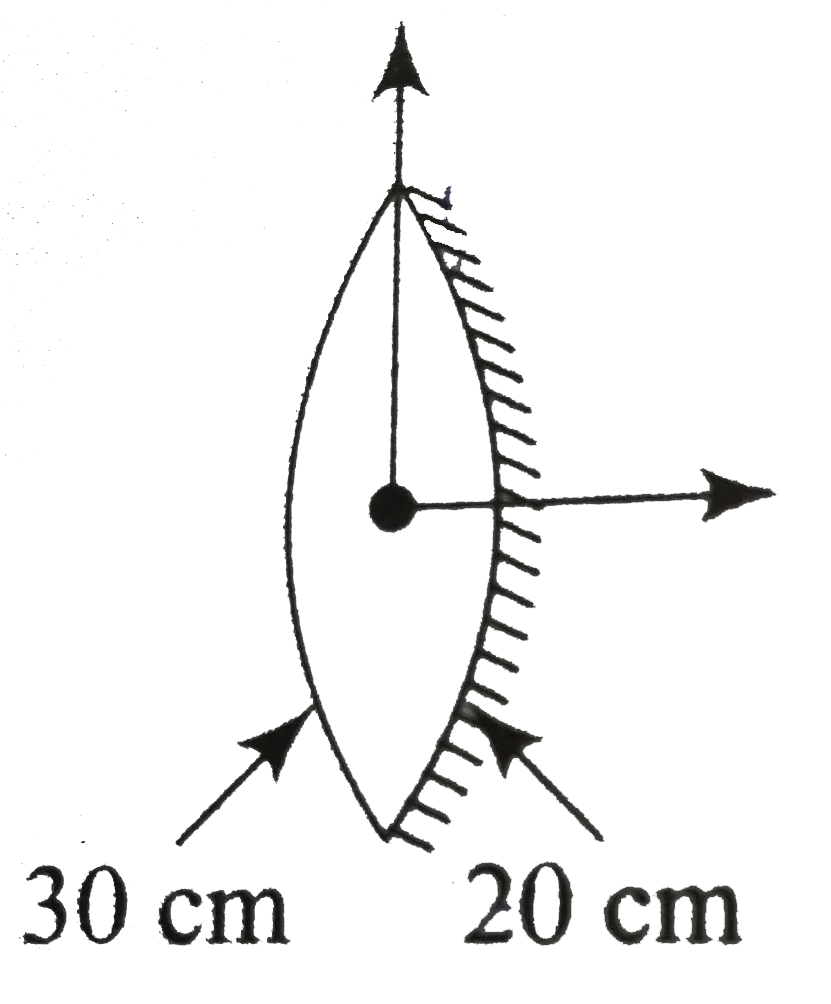A double convex lens is made of glass which has refractive inded 1.55 for voilet rays and 1.50 for red rays. If the focal length for violet rays is 20 cm, the focal length for red rays will be
9 cm
28 cm
20 cm
22 cm
The correct Answer is:D
To find the focal length of the red rays using the given information, we can follow these steps:
1. Identify the Given Values:
- Refractive index for violet rays (μv) = 1.55
- Refractive index for red rays (μr) = 1.50
- Focal length for violet rays (fv) = 20 cm
2. Use the Lens Maker's Formula:
The lens maker's formula is given by:
1f=(μ−1)(1R1−1R2)
Here, R1 and R2 are the radii of curvature of the lens surfaces. Since the lens is the same for both violet and red rays, R1 and R2 will be the same for both cases.
3. Set Up the Equations:
For violet rays:
1fv=(μv−1)(1R1−1R2)(1)
For red rays:
1fr=(μr−1)(1R1−1R2)(2)
4. Divide Equation (1) by Equation (2):
frfv=μv−1μr−1
5. Rearrange to Find fr:
fr=fv⋅μv−1μr−1
6. Substitute the Known Values:
- fv=20 cm
- μv−1=1.55−1=0.55
- μr−1=1.50−1=0.50
Now substituting these values:
fr=20⋅0.550.50
7. Calculate fr:
fr=20⋅1.1=22 cm
Final Answer:
The focal length for red rays (fr) is 22 cm.
---
- Refractive index for violet rays (μv) = 1.55
- Refractive index for red rays (μr) = 1.50
- Focal length for violet rays (fv) = 20 cm
The lens maker's formula is given by:
1f=(μ−1)(1R1−1R2)
Here, R1 and R2 are the radii of curvature of the lens surfaces. Since the lens is the same for both violet and red rays, R1 and R2 will be the same for both cases.
For violet rays:
1fv=(μv−1)(1R1−1R2)(1)
For red rays:
1fr=(μr−1)(1R1−1R2)(2)
frfv=μv−1μr−1
fr=fv⋅μv−1μr−1
- fv=20 cm
- μv−1=1.55−1=0.55
- μr−1=1.50−1=0.50
fr=20⋅0.550.50
fr=20⋅1.1=22 cm
The focal length for red rays (fr) is 22 cm.
Topper's Solved these Questions
- GEOMETRICAL OPTICSBOOK - AAKASH SERIESCHAPTER - GEOMETRICAL OPTICSEXERCISE - ADDITIONAL PRACTICE EXERCISE -I (LEVEL-II LECTURE SHEET (ADVANCED) STRAIGHT OBJECTIVE TYPE QUESTIONS)
29 Videos
- GEOMETRICAL OPTICSBOOK - AAKASH SERIESCHAPTER - GEOMETRICAL OPTICSEXERCISE - ADDITIONAL PRACTICE EXERCISE -I (LEVEL-II LECTURE SHEET (ADVANCED) MORE THAN ONE CORRECT TYPE QUESTIONS)
3 Videos
- GEOMETRICAL OPTICSBOOK - AAKASH SERIESCHAPTER - GEOMETRICAL OPTICSEXERCISE - PRACTICE SHEET (EXERCISE III LEVEL -II (ADVANCED) INTEGER TYPE QUESTIONS)
4 Videos
- ELEMENTS OF VECTORSBOOK - AAKASH SERIESCHAPTER - ELEMENTS OF VECTORSEXERCISE - QUESTIONS FOR DESCRIPTIVE ANSWERS
10 Videos
- LAWS OF MOTIONBOOK - AAKASH SERIESCHAPTER - LAWS OF MOTIONEXERCISE - PRACTICE EXERCISE
106 Videos
Similar Questions
Knowledge Check
A double convex lens is made of glass of refractive index 1.55 with both faces of same radius of curvature. Find the radius of curvature required, if focal length is 20cm.
A11cmB22cmC7cmD6cm
A double convex lens is made of glass of refractive index 1.55 with both faces of same radius of curvature. Find the radius of curvature required, if focal length is 20cm.
View SolutionA double convex lens is made of glass of refractive index 1.55 with both faces of same radius of curvature. Find the radius of curvature required, if focal length is 20cm.
View SolutionA plano-convex lens is made of refractive index of 1.6. The focal length of the lens is
View SolutionA biconvex lens is made of glass with refractive index 1.5 and has radii of curvature 20 cm and 30 cm. If the 20 cm surface is silvered, what is the effective focal length of the mirror formed?

View SolutionA biconvex lens made of glass (refractive index 1.5) has two spherical surfaces having radii 20cm and 30cm. Calculate its focal length.
View SolutionA thin liquid convex lens is formed in glass. Refractive index of liquid is 4/3 and that of glass is 3/2. If f is the focal length of the liquid lens is air, its focal length and nature in the glass is
View SolutionA double convex thin lens made of glass of refractive index 1.6 has radii of curvature 15 cm each. The focal length of this lens when immersed in a liquid of refractive index 1.63 is :
View Solution
